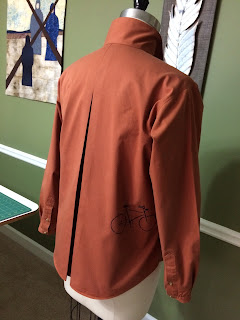This post documents an episode in my continuing search for the perfect pants. Perfectly fitting pants are the holy grail for most garment sewers and I am no exception. I keep thinking I've got the perfect pattern but then I become disenchanted. Note: I'm looking for good looking pants for non-stretch fabrics. Stretch pants are easier, I think, but I generally prefer woven fabrics.
My last make of pants used the Quincy from the Sewing Workshop, their pattern for narrow-leg pants using non-stretch fabrics. I've made them three times now, most recently on New Year's Eve. The last pair was made from a drapey rayon twill. They feel delicious.
But I need to admit that they are not flattering on me.
They are a little too big on me (I think) but the more significant problem is that narrow pants can create a pegged look that I do not think is attractive. You see them everywhere on women large and small. I'm not sure I even like them on small people, but that is not my problem.
So I made selfies in a number of favorite pants. It is a bit difficult to see the silhouette since I almost always make dark pants.
These are the Hudson pants, from the Sewing Workshop, made in a medium weight denim. The funky hemline makes them a bit distinctive and the style calls for slightly cropped length. I love these in the warm months but they are little odd with socks and dark shoes, I think.
In sum, I like the shape and the overall pattern a lot. I'll give these a
B+
***************************************************
These are tapered one-seams from Cutting Line Designs. I've made these a lot and they are wonderfully comfortable. The fit is as good as possible. The silhouette is not bad but the manner in which they are tapered leads to some twisting of the grain. I can see it because these pants are a discretely striped wool. Probably no one else can tell at all.
In sum, these are OK. I'll give these a
B
***************************************************
And here is the Quincy pants pattern from the Sewing Workshop, made up in my nice drapey rayon. I took this picture over and over again thinking I had the angle wrong. These create a pegged look that I like less. Admittedly they could be narrowed at the side seams and I could shorten the hems some.
Bottom line, these are my least favorite. I'll give these a
C
***************************************************
These are the Plaza pants from the Sewing Workshop, pretty close to a straight-leg, or stove-pipe pant. I think I like these best of the lot especially when I'm seeking a trouser look. They are comfortable; they have a center front seam which serves only to provide a vertical line and a pretty pleat. Time to remake these!
A
***************************************************
These are a pair of jeans-like pants made from a medium-weight denim. It is an old OOP pattern for Vogue by Sandra Betzina, fitted on me by Sandra herself! It's good pattern to tweak because each leg has 4 vertical seams - side seams, inseams, and princess seams down the center front and center back. It allowed her to adjust for flat butt, thighs (I have them), tummy and high hip fluff. These pants require a zipper and are more close fitting than the others. I like them a lot but not for all fabrics, and the silhouette is still pegged a little. The jeans fit requires sturdy fabric, I think. For narrow pants in non-stretch fabric I rate them
A-
I have some nice stash wool I hope to use for Plaza pants very soon! So what are you sewing?





















































